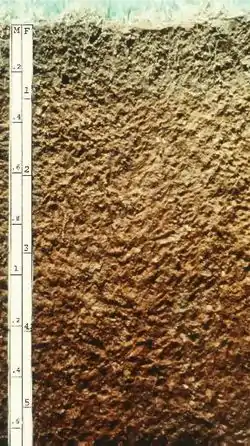Alfisol
Alfisols are a soil order in USDA soil taxonomy. Alfisols form in semi-arid to humid areas, typically under a hardwood forest cover. They have a clay-enriched subsoil and relatively high native fertility. "Alf" refers to aluminium (Al) and iron (Fe). Because of their productivity and abundance, the Alfisols represent one of the more important soil orders for food and fiber production. They are widely used both in agriculture and forestry, and are generally easier to keep fertile than other humid-climate soils, though those in Australia and Africa are still very deficient in nitrogen and available phosphorus. Those in monsoonal tropical regions, however, have a tendency to acidify when heavily cultivated, especially when nitrogenous fertilizers are used.
| Alfisol | |
|---|---|
 an Alfisol profile | |
| Used in | USDA soil taxonomy |
| Climate | various |
In the World Reference Base for Soil Resources (WRB), most Alfisols are classified as Luvisols or Lixisols, but some are classed as Retisols or Nitisols. Aqualfs are mainly Stagnosols or Planosols. Alfisols with a natric horizon are mainly Solonetz.[1]
Alfisols occupy around one-tenth of the Earth's ice-free land surface. They are dominant in many areas, such as the Ohio River basin in the United States, southern and unglaciated Western Europe, the Baltic region and central European Russia, the drier parts of Peninsular India, Sudan in Africa, and many parts of South America.
Alfisols have undergone only moderate leaching. By definition, they have at least 35% base saturation, meaning calcium, magnesium, and potassium are relatively abundant. This is in contrast to Ultisols, which are the more highly leached forest soils having less than 35% base saturation. In eastern North America, Alfisols are commonly found in glaciated areas while Ultisols are restricted to the areas south of the limit of maximum glaciation.
The fossil record of Alfisols begins in the Late Devonian. Probably owing to their fertility, they are the oldest forest soils; vegetation on weathered Oxisols, by contrast, is not known earlier than Middle Permian. Fossil Alfisols remain common from the Carboniferous and all periods since the Eocene.
Suborders
- Aqualfs – This suborder is saturated with water long enough to cause oxygen depletion. Almost all of this suborder is thought to have been forested at some point. Redoximorphic features are present.
- Cryalfs – This suborder occurs mainly in high elevations which tend to be cold with temperatures ranging from greater than 0 C to less than 8 C.
- Udalfs – This suborder is located in humid or subhumid climates. All of this suborder is thought to have been forested at some point.
- Ustalfs – This suborder is located in semiarid climates with wet summers and dry winters.
- Xeralfs – This suborder is located in mediterranean climates with very dry summers and wet winters.
See also
| Wikimedia Commons has media related to Alfisols. |
External links
- "Alfisols". United States Department of Agriculture. Archived from the original on 2007-10-18. Retrieved 2008-01-04.
- "Alfisols". University of Idaho. Archived from the original on 2006-09-01. Retrieved 2006-05-14.
- IUSS Working Group WRB (2015). "World Reference Base for Soil Resources 2014, Update 2015" (PDF). World Soil Resources Reports 106, FAO, Rome.